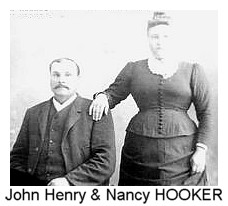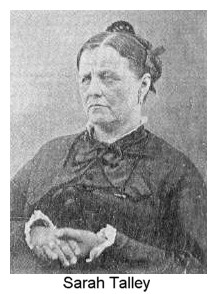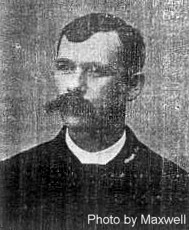|
GREAT LAND O' GOSHEN!
by Lawrence P. TODD

NOTE: The language contained is of the time, not considered politically correct by present-day
standards. In the transcription below, I did not change the text outside of a few punctuation marks for clarity. - SRB

Hard by Bethel cemetery and later given the name of Goshen, the cradle of Ringgold County lies just southwest of
Diagonal. For about one century stout-hearted settlers endured the bitterly cold winds of winter-time. When summer came
they managed to wrest a living from the shallow soil. Shortly before the turn of the century a groundhog stood upright and
whistled with alarm as a locomotive sped down the Grand River valley. The building of the Great Western sealed the doom of
the little hamlet and only a few short lines of history plus a fast-dwindling group of old-timers tell of its existence.
The original Goshen was the ancient land of the Israelites and was an upland country east of the Nile River. The shallow soil
was extremely fertile and suitable for the grazing of sheep and goats. Orchards were usually laden with fruit and for many
years the people were well off.
To better understand the name of Goshen let us go far beyond the shades of antiquity and examine one of the most
fascinating events of all time.
About four thousand years ago a battle had been lost and an entire tribe was being driven into the sea. Almost at that exact
moment a mountain blew its top and an island nation sank below the sea. Many cubic miles of salt water poured into the
void, the water level dropped and the muddy sea bottom became an escape route. Within minutes one of the great Bibilical dramas
was being played out. Wildly pursued by the Egyptians the Israelites slogged their way across the muddy sea bottom. Supposedly
bearing the Ark of the Covenant, the Ten Commandments and the Candlestick and Rod of Aaron, the Israelites scarcely reached
dry land with the Eqyptian army was engulfed by a monster tidal wave. A short time later only laughing waters remained where
a proud army had been certain of victory. The crossing of the Israelites is mentioned in Genesis and the whole affair
probably represents the destruction and disappearance of the lost continent of Atlantis. The land from which the
Israelites had fled was Goshen and later became an expression of amazement and was referred to as "Great Land O' Goshen."
About twenty years after the United States became a new nation, a number of eastern residents were suspected and accused of
occult practice. Some lost their lands and were banished from society and all religious services. Fearing a revival of the
ancient Mather witchcraft trials, sickened by the loss of their property, and the fact that the public debt had risen to
the staggering total of seventy-five millions of dollars, these old-timers called the dog and followed by their wives and
children moved westward. They had a hiderack yoke of oxen, bony-hipped cattle, a few sheep and goats, several geese
and a number of chickens. They crossed the Allegeheny and the Beaver, and after rafting a nameless river, spent the winter
on the east bank of the Mississippi. Before the ice broke, they crossed the Father of Waters and were on soil that
was to become the State of Iowa. Weeks later the little group fought the deep sand of what was to become the Lafe HERSOM hill
and entered the un-named valley of the West Grand. About one mile from the present town of Diagonal, Mr. BURNS, the
leader and patriarch called a meeting of all hands. He said in part the critters were too weak to travel, the cart had
broken down, the dog had been snake bit, they were all barefooted and the old gentleman vowed he would go no "furder." Pointing
toward the land that was to become the property of Nancy HOOKER, he announced that up there he would build a home that
could never be taken away.
 NOTE: Lafe HERSOM is Lafayette HERSOM (1878-1935), interred at Centenary
Cemetery. Nancy HOOKER is Nancy Catherine (YARYAN) HOOKER (1857-1920), interred at Clearfield Cemetery. Nancy was the
daughter of John Morgan & Susanna B. (HARMON) YARYAN; the wife of John Henry "Rog" HOOKER (1851-1904). It isn't clear
who Mr. BURNS was.
NOTE: Lafe HERSOM is Lafayette HERSOM (1878-1935), interred at Centenary
Cemetery. Nancy HOOKER is Nancy Catherine (YARYAN) HOOKER (1857-1920), interred at Clearfield Cemetery. Nancy was the
daughter of John Morgan & Susanna B. (HARMON) YARYAN; the wife of John Henry "Rog" HOOKER (1851-1904). It isn't clear
who Mr. BURNS was.
Sometime around 1798 these people who had fled the accusation of wichcraft squatted on that was destine to be part of
Ringgold County. A short distance northwest of the second Great Western trestle below Diagonal, is the location of
the first homes. These houses were simple excavations in the hillside. They had a pole roof covered with layers of
grass, sod and dirt. The downshill side or front was enclosed by hides of animals. A wooden fence along the ends and
upper side kept domestic animals from dropping in when least expected. Game and fish were plentiful, herds of buffalo
browsed up and down the river, and the settlers became hunter, trappers, and fishermen. For a time people lived the
life of Riley and then one dark night it happened. A waggish young Indian slipped into the settlement andlaid a hide over the
smoke vent of one of the houses. Unfortunately he had paid no attention to the honking of an old gander and was caught
in the act. Suddenly seized from behind, the luckless Indian was trussed up like a Christmas turkey, a grapevine
binding his ankles, and a few minutes later the panic-stricken brave found himself hanging head downward from the limb
of a fair sized tree. About when his eyes began to bulge, the grapevine parted and the waggish one fell like a dead cat
thrown from a bridge. Fortunately the Indian was only shaken up and when released took a hasty departure. Fearing the
worst the settlers prepared for an Indian reprisal. It was known a number of Indians under Chief Wah-zow-Ko-Uck (Sun Dog)
were camped about three-quarters of a mile southeast of the present Diagonal townsite near a small creek.
NOTE: Chief Wah-zow-ko-uck was of the Prairie Band of the Pottawattomie, later removed to
Nemaha Agency in Kansas. Many years later Ed WRIGHT named the creek of the Indian village "The Sand SLOUGH."
It is likely the humiliated brave kept the escapade strictly to himself. However, it is known that Sun Dog feared the
people who lived in earthen teepees. He had seen too much. One morning he watched as white men heated water over an open
fire and began rubbing themselves with the steaming water. This was enough to shatter the Indian and their shouts and
laughter sent a bolt of fear through the old chief. From that time onward, Indians never bothered the settlers.
A number of years later the Great Spirit called and Sun Dog quietly entered the long sleep. Then began a ritual
which lasted for several days. Finally, dressed in the trappings of a Chief, the body was laid on a high rack above a
flat rock and left to the sun. Meanwhile, his most prized possession, a petrified turtle believed to be bad
medicine was carried northward and hurled into the ditch. According to the old legend this tribe traveled far to the
southwest and camped on the bank of the Washita, not far from the present Anadarko, Okla. The above mentioned rock is
a large piece of gray granite entirely foreign to the hills of Ringgold County and probably deposited by the great
ice sheet [glacier]. It is about 500 yards east and a little south of the sexton house at the Diagonal cemetery, or
better still, it lies on the west side of a deep ditch about 200 yards north of the city dump. In many ways this writer
has been personally involved with the history and disposition of the Indian stone. When my father
[Henry TOOD] died in 1910, his will
(which I have) directed the stone be removed and placed on his grave in the Diagonal Cemetery, where it was to be
inscribed with his name, date of birth and death. However, the failure of the DUNNING bank in Mount Ayr had destroyed the
finances of our family, and another gravestone had to be substituted. More than sixty years have passed since 1910 and it
would seem that the rock should be given to the memory of the old Chief. For the benefit of historians, I would hope at
some future date to have it inscribed: Chief Wah-Zow-Ko-uck
Died 1836.By the time Iowa became a
State, many of the original settlers had gone on to their reward. A few had drifted away and later in 1849, others joined
the California gold seekers. The wind-swept ridge was coming alive, a trading post and combination wagon and blacksmith shop
had been established. A few houses were built and all foot-burners in the community (walking ploughs) were turning up small
patches of soil. Back in those days sod busting was a united efford. Two men held the handles of the oxen-drawn plough,
meanwhile boys with pole axes walked ahead chopping toughest portions of the prairie sod. After ploughing, a fair-sized
tree was dragged back and forth to harrow the seed bed. All planting was done with a few implements and by hand and it
was likely most were relieved when the job was done. At the smithy,
Mike STAHL, a deeply religious man, burned a
name into the flat side of a split log. Propped against the side of the trading post the crude sign bore the one word -
"Goshen." Nobody complained and the name was adopted.
 The TALLEY family has long been associated with the teachings of the Bible and from Adam to Isaac were never reluctant to
spread the word of God. Adam TALLEY started the first Goshen class of Bible studies and probably helped build a church
in the hamlet. I am not certain be believe that later on it was moved and became the Methodist church of Diagonal. Just
before construction of the new church (finished about 1911) it was moved to about one-half block south of the present
Reporter office and was used for the storage of machinery. Within a short time the old building was destroyed by fire.
(Correct me if I am wrong in stating this church came from Goshen.)
The TALLEY family has long been associated with the teachings of the Bible and from Adam to Isaac were never reluctant to
spread the word of God. Adam TALLEY started the first Goshen class of Bible studies and probably helped build a church
in the hamlet. I am not certain be believe that later on it was moved and became the Methodist church of Diagonal. Just
before construction of the new church (finished about 1911) it was moved to about one-half block south of the present
Reporter office and was used for the storage of machinery. Within a short time the old building was destroyed by fire.
(Correct me if I am wrong in stating this church came from Goshen.) Folks were proud of the little schoolhouse where boys
and girls began the day with a short prayer and were taught the three R's. Here they read from the McGuffey readers and
pored (sic) Emma WILLARD's history of the United States. This school was never a backbreaker to taxpayers. Old-timers were
aware that an education rests squarely on the efforts of each student, and the constant appropriation of money does not
assure an education. At one time the citizens were plagued by the antics of a few drunken drifters. To cope with these
disturbances a crude pillory was erected behind the stores. After an hour or so in the pillory most drifters were
released and lost no time getting away from the community. When a special investigator was sent to probe this cruel and
unusual punishment all he found was a pile of ashes and several smouldering logs. Goshen was once the scene of pioneer
wrath and frontier punishment. An itinerant had attacked the wife of a local farmer. Outraged citizens caught up with the
criminal who resisted capture and threatened to fire on any man who came a step closer. Several muzzle loaders blazed and
the almost decapitated man was instantly killed. Near a large spring on Hane JARVIS' property, several men dug a shallow
grave and the body was given to the earth. Strangley enough, goats were innocently and indirectly involved in mid-Western
history. These animals were quite prolific and at one time practically over-ran Goshen. They climbed rail fences, butted
anything that moved, ate all chewable items and were a general nuisance. It was known that a buyer was camped somewhere
near the Waubonsie Trail and a decision was quickly made. The goats had to go! Long before daylight most of the
bearded creatures were rounded up and driven toward a shallow ford in the Grand River. At the river bank it seemed
Mephistopheles himself had gotten into the herd. At this point a number of the horned gentry began to settle old scores
and the solid whack of horns and heads mingled with the shouts and clubbing of the drovers. One staunch old Methodist
forgot himself, backslid and used language that would have shocked a wagon driver. Finally, at long last the herd climbed
the bank of the ZIMMERMAN place and going was much easier. Skirting the farm of Lon CLARK the herd followed a
southeasterly course. About one mile north of the Waubonsie an old gentleman "cut slug" at the first goat to set foot on
his property. Accordingly he was given a wide berth and without incident the herders found the spot where the buyer had
built a new "ketch pen" near the Indian trail. This pen was close to the Bedbug school and was jokingly referred to as
the Goat Ground and later became a meeting place for men of good will. (More about that later.) After considerable
haggling the entire herd was sold for fifteen dollars. Actually this was indeed a windfall for the Goshenites would
gladly have given the animals to anyone had they found takers. The first round up of stray Indians occurred in the mid-fifites
[1850's]. A number were herded together and under armed guard were escorted to the squalor of a reservation. Some
eventually escaped, others accepted meager food supplies and spent muchtime practising the ritual
of an Indian secret society.
 End of the great war [Civil War] and assassination of President LINCOLN brought a new flood
of settlers and problems to the countryside.
End of the great war [Civil War] and assassination of President LINCOLN brought a new flood
of settlers and problems to the countryside. Money was hard to come by and many business transactions were by barter. Jim,
Henry and Colonel TODD were traders and were sometimes soundly trounced. Jim ran the store and would trade for anything.
The place was jam packed with probably the most amazing stock of items within a fifty-mile radius, and for many years had the
reputation of being a storekeeper's nightmare. Spring always broght Old Doc and the treatment of many ills. He
had considerable medical knowledge and treated everything from the grippe to a case of seven wonders. He was a firm
adherent to the practic of blood-letting and bled patients both physically and financially. Back in those days many
folks wore ill-fitting boots and these were the prime cause of corns, bunions, and ingrown toenails. Old Doc's treatments
were in great demand. However, an ingrown toenail led to the downfall of the old gentleman. One afternoon a local
character limped in to the old doctor. An infected great toe had filled with pus and swollen to almost twice its normal
size. While the patient held onto a bench, Old Doc gently lifted the nail from the tender flesh. Suddenly the nail slipped
back from the blade and snapped back. Completely stunned by the disaster, the poor fellow remained in shock for a few
seconds and then struck by uter horror and the agony of the bloody murder, drew a pistol and swore he would shoot Old Doc
squarely between the eyes. Sometimes later after sympathetic loafers had calmed the outraged patient it was discovered
the Doctor had slipped out the back door and was nowhere to be found. Goshen Postoffice
For a time Goshen had a postoffice. This was sort of a hat and hip pocket affair and the postmaster usually personally
delivered the mail. Back in those days arrival of a letter shook up the whole community, often bringing news of far-away
places, of relatives, friends and other interesting events. Now and then letters told of the birth of a child or the death
of a loved one. They were read and re-read and usually the news spread through the entire community. This postoffice existed
for a considerable number of years and was probably discontinued in the latter part of the gay ninties.
The Goshen post office operated from 1872 to 1889. A group of men quietly gathered at the Goat Ground. They
came from Mount Ayr, Goshen, and from farms inthe county. All were politcally minded. A few were veterans and had been
through the mill. One had survived a wild un-ordered charge up Missionary Ridge, anther a eteran of Shiloh spoke for several
minutes and ended with the remark that he never wanted to see another man killed. After considerable discussion, Henry
TODD, a quill pen scribe, was instructed to write letters to President GRANT, General SHERIDAN and the Secretary of War,
protesting [General George Armstrong] CUSTER's being sent on this new mission [to fight the Sioux in the West]. So far as
is known, these letters were never acknowledge and probably were placed in file thirteen.
NOTE: Mr. TOOD goes into a recounting of the Indian Wars, ending with the Battle of the Little Bighorn, which I have clipped because
it does not relate to Ringgold County, Iowa. - SRB Once again it has been a pleasure to write of the happenings
of long ago and especially of the history and legends of Ringgold County, and those old-timers who worked and fought to make this
country a great nation. Now my final remembrance of Goshen: a wooden hitchrail standing in a soupy mudhole, a board
sidewalk and three stores. - Lawrence P. TODD
SOURCES:
freepages.genealogy.rootsweb.ancestry.com/~kansasindians/Pottawatomie_Prairie_Band.html
Transcription and notes by Sharon R. Becker, May of 2010


| 

